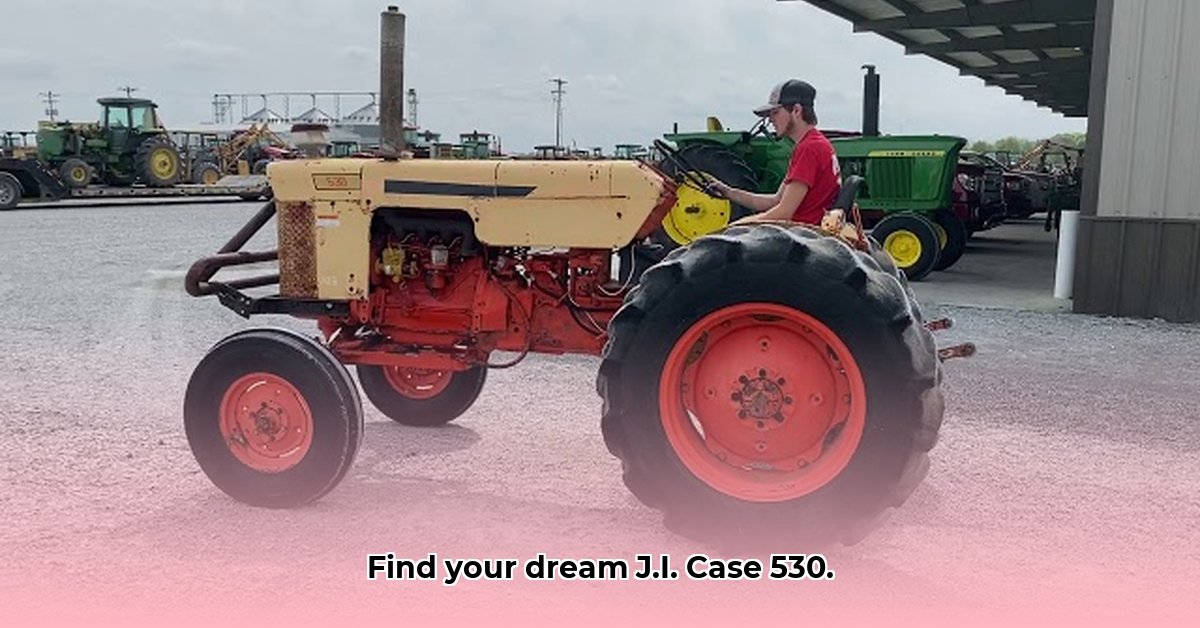
The J.I. Case 530: a name that conjures images of hardworking farmhands and a bygone era of agricultural innovation. More than just a machine, the 530 represents a significant piece of agricultural history and a compelling investment for collectors. This comprehensive guide will equip you with the knowledge to find the perfect J.I. Case 530 tractor for your needs, whether you’re a seasoned collector or a curious enthusiast. For more Case tractor information, check out this helpful resource: Case Tractor Info.
Technical Specifications: Understanding the Workhorse
The Case 530 boasts a robust four-cylinder diesel engine, delivering approximately 37-41 horsepower (depending on PTO or drawbar use). This power is channeled through a durable 12-speed transmission, a combination of gears and a torque converter that provided impressive versatility for its time. Weighing in at around 4,000 pounds, the 530 was built to withstand the rigors of farm life. Tire sizes varied slightly across models, highlighting the importance of detailed inspection.
Production History & Variants: A Family of Farmers
Production of the Case 530 spanned from 1960 to 1969, resulting in a family of related models. The standard 530 diesel was joined by the row-crop optimized 531 diesel, the gasoline-powered 540, its row-crop counterpart the 541, and the highly sought-after 530CK, featuring a front loader and backhoe. This diversity significantly impacts value and availability. Understanding these differences is crucial for targeted searches. Did you know that production numbers for these varied greatly, affecting their current market value?
Market Analysis: Navigating the Price Landscape
The price of a classic Case 530 today is highly variable—a testament to the condition and rarity of these machines. While a new 530 cost approximately $5,700 in 1969, current prices range significantly from relatively affordable to well over $7,500. Condition is paramount; a meticulously restored tractor will command a much higher price than one in need of extensive repair. Rarity also plays a role, with the 530CK often holding higher value. Online resources like TractorData and TractorHouse provide valuable data on current market trends. Is this a sound investment? The answer depends on condition and model.
Restoration & Maintenance: A Labor of Love
Restoring a vintage Case 530 can be immensely rewarding but demands dedication. Part availability varies across models and years, making online forums and vintage tractor communities invaluable. "Finding parts can be a scavenger hunt," notes Sarah Miller, a restoration specialist from the American Tractor Association. "But the community is incredibly supportive." Restoration costs can be substantial; careful budgeting is critical.
Collector's Guide: Finding Your Perfect Match
Acquiring a Case 530 begins with diligent online searches, utilizing auction sites and specialized marketplaces. Thorough inspection is non-negotiable. Check for wear and tear, test key components such as the engine, transmission, and hydraulics. "Don’t skip the test run," advises John Peterson, a seasoned Case 530 collector. "It's the only way to truly assess functionality." Engaging with online collectors' groups can provide invaluable knowledge and expand your search capabilities.
Assessing Your J.I. Case 530 Investment: A Calculated Risk?
Investing in a classic tractor involves passion and shrewdness. Here's a balanced look at the potential pros and cons:
Pros: Potential appreciation, owning a piece of history, a supportive community. Cons: High restoration costs, parts sourcing challenges, market fluctuation, mechanical expertise sometimes needed.
Key Takeaways:
- The Case 530 embodies a rich history and enduring appeal.
- Market value depends heavily on condition, rarity, and model.
- Restoration requires research, parts sourcing, and mechanical skill.
Choosing your Case 530 requires research, patience, and a dash of good fortune. But for those captivated by this piece of Americana, the journey is as fulfilling as the reward.